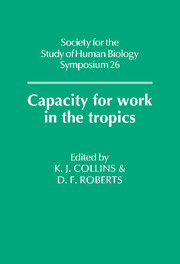Book contents
- Frontmatter
- Contents
- Preface
- Measurement of Working Capacity in Populations
- Functional Consequences of Malnutrition
- Malnutrition, work output and energy needs
- The role of working women in a rural environment when nutrition is marginally adequate: problems of assessment
- Defining anaemia and its effect on physical work capacity at high altitudes in the Bolivian Andes
- Marginal malnutrition in childhood: implications for adult work capacity and productivity
- Marginal energy malnutrition: some speculations on primary energy sparing mechanisms
- Growth, Stature and Muscular Efficiency
- Ethnic and Socio-Cultural Differences in Working Capacity
- Energy Expenditure and Endemic Disease
- Research Models in Tropical Ecosystems
- Index
Malnutrition, work output and energy needs
Published online by Cambridge University Press: 15 March 2010
- Frontmatter
- Contents
- Preface
- Measurement of Working Capacity in Populations
- Functional Consequences of Malnutrition
- Malnutrition, work output and energy needs
- The role of working women in a rural environment when nutrition is marginally adequate: problems of assessment
- Defining anaemia and its effect on physical work capacity at high altitudes in the Bolivian Andes
- Marginal malnutrition in childhood: implications for adult work capacity and productivity
- Marginal energy malnutrition: some speculations on primary energy sparing mechanisms
- Growth, Stature and Muscular Efficiency
- Ethnic and Socio-Cultural Differences in Working Capacity
- Energy Expenditure and Endemic Disease
- Research Models in Tropical Ecosystems
- Index
Summary
INTRODUCTION
There continues to be a great deal of interest, particularly among nutritionists and development economists, in the functional significance of malnutrition. The term “malnutrition” generally refers to all deviations from adequate nutrition, including energy undernutrition or overnutrition and specific deficiencies or excesses of essential nutrients. In the context of this presentation, however, the term “malnutrition” refers to the nutritional situation characteristic of low socioeconomic populations in underdeveloped areas of the world. The diets in these populations are characterised by two predominant features: (1) insufficiency in amounts which results in a deficit of food energy for the majority of the people; and (2) limited quality and inadequate number and variety of food items, aspects which constrain the achievement of a balanced diet with appropriate concentrations of all the essential nutrients (nutrient density). The consequence is the concurrence of undernutrition and specific nutritional deficiencies. Alan Berg (1981), from the World Bank, sees malnutrition not only as an outcome of poverty but as a deterrent to economic progress. One way through which Berg (1981) believes malnutrition is damaging is by limiting work capacity and productivity in workers. At the same time, there are those that have criticised nutritionists for exaggerating the extent of world hunger and malnutrition (Seckler, 1980; Poleman, 1981; Sukhatme & Margen, 1982). In their view, malnutrition is not as common or as serious as is generally claimed and therefore should not be included among the significant factors limiting productivity of workers.
- Type
- Chapter
- Information
- Capacity for Work in the Tropics , pp. 57 - 76Publisher: Cambridge University PressPrint publication year: 1988
- 11
- Cited by



